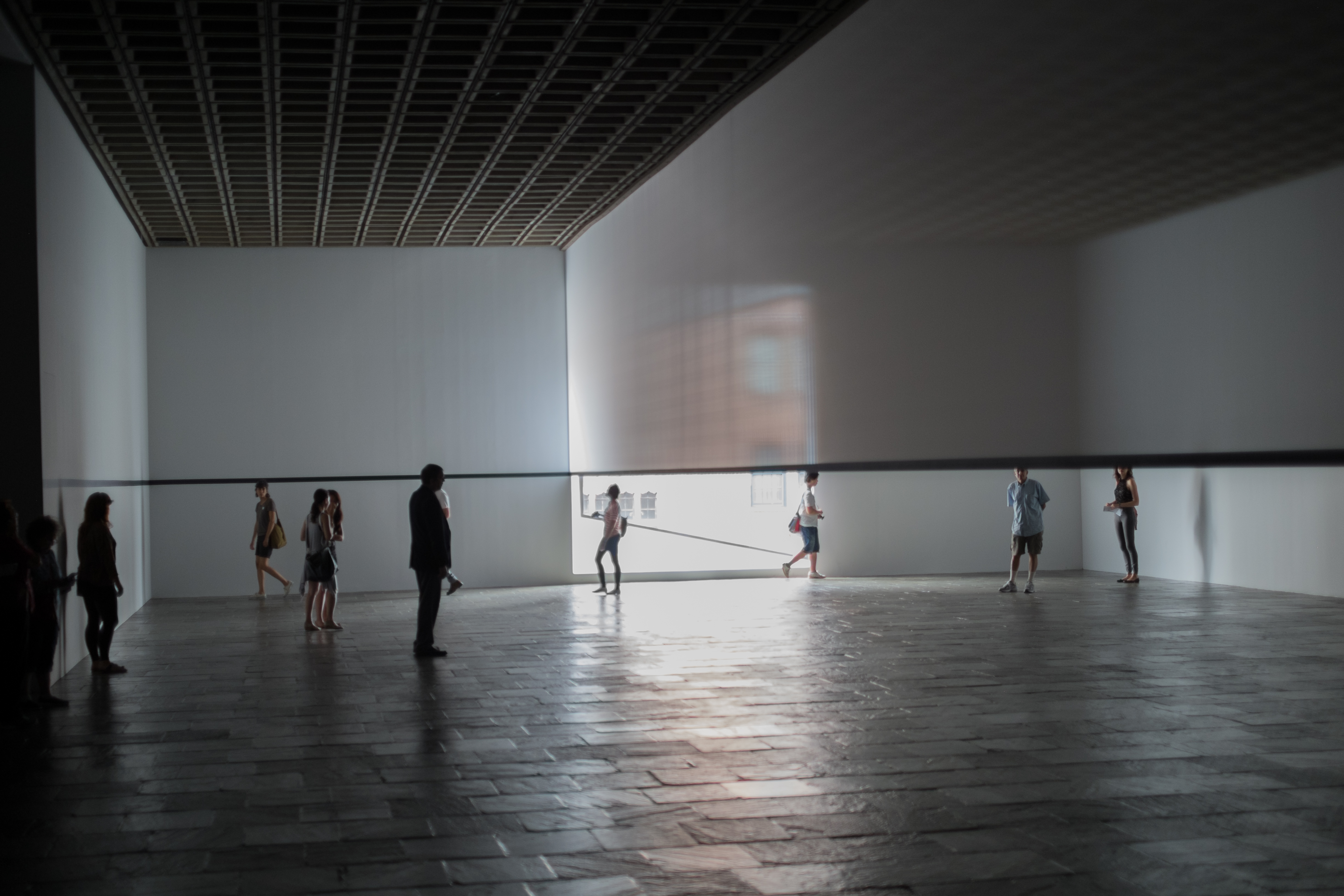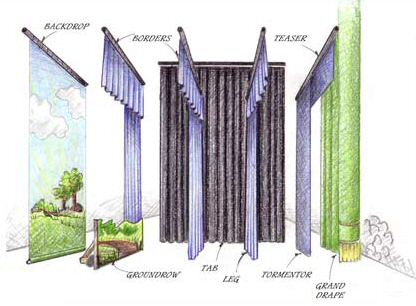|
Cyclorama (theater)
In theater and film, a cyclorama (abbreviated cyc in the U.S., Canada, and the UK) is a large curtain or wall, often concave, positioned at the back of the apse. It often encircles or partially encloses the stage to form a background. It was popularized in the German theater of the 19th century and continues in common usage today in theaters throughout the world. It can be made of unbleached canvas (larger versions) or muslin (smaller versions), filled scrim (popularized on Broadway in the 20th century), or seamless translucent plastic (often referred to as "Opera Plastic"). Traditionally it is hung at 0% fullness (flat). When possible, it is stretched on the sides and weighted on the bottom to create a flat and even surface. As seams tend to interrupt the smooth surface of the cyclorama, it is usually constructed from extra-wide material. In photography, cycloramas or cycs also refer to curving backdrops which are white to create the illusion of no background, or green for chroma ... [...More Info...] [...Related Items...] OR: [Wikipedia] [Google] [Baidu] |
Apse
In architecture, an apse (plural apses; from Latin 'arch, vault' from Ancient Greek 'arch'; sometimes written apsis, plural apsides) is a semicircular recess covered with a hemispherical vault or semi-dome, also known as an ''exedra''. In Byzantine, Romanesque, and Gothic Christian church (including cathedral and abbey) architecture, the term is applied to a semi-circular or polygonal termination of the main building at the liturgical east end (where the altar is), regardless of the shape of the roof, which may be flat, sloping, domed, or hemispherical. Smaller apses are found elsewhere, especially in shrines. Definition An apse is a semicircular recess, often covered with a hemispherical vault. Commonly, the apse of a church, cathedral or basilica is the semicircular or polygonal termination to the choir or sanctuary, or sometimes at the end of an aisle. Smaller apses are sometimes built in other parts of the church, especially for reliquaries or shrines of saints. Hi ... [...More Info...] [...Related Items...] OR: [Wikipedia] [Google] [Baidu] |
Stage (theatre)
In theatre and performing arts, the stage (sometimes referred to as the deck in stagecraft) is a designated space for the performance of productions. The stage serves as a space for actors or performers and a focal point (the screen in cinema theaters) for the audience. As an architectural feature, the stage may consist of a platform (often raised) or series of platforms. In some cases, these may be temporary or adjustable but in theaters and other buildings devoted to such productions, the stage is often a permanent feature. There are several types of stages that vary as to the usage and the relation of the audience to them. The most common form found in the West is the proscenium stage. In this type, the audience is located on one side of the stage with the remaining sides hidden and used by the performers and technicians. Thrust stages may be similar to proscenium stages but with a platform or performance area that extends into the audience space so that the audience ... [...More Info...] [...Related Items...] OR: [Wikipedia] [Google] [Baidu] |
Scrim (material)
A scrim is a woven material, either finely woven lightweight fabric widely used in theatre, or a heavy, coarse woven material used for reinforcement in both building and canvasmaking. Light gauzy material A scrim or gauze is often a very light textile made from cotton, or sometimes flax or other materials. It is lightweight and translucent, which means it is often used for making curtains. The fabric can also be used for bookbinding and upholstery. Scrims have seen extensive use in theatre. There are several types used for special effects. The variety typically used for special effects is called ''sharkstooth scrim''. However, in theater a scrim can refer to any such thin screen, and is made out of a wide variety of materials. Sharkstooth scrim is woven and earns its name because the weave resembles a set of triangles that resemble a shark's teeth with openings similar in size to a window screen's. The most common effects that scrim is used for is the 'reveal effect', in whic ... [...More Info...] [...Related Items...] OR: [Wikipedia] [Google] [Baidu] |
Chroma Key
Chroma key compositing, or chroma keying, is a visual-effects and post-production technique for compositing (layering) two images or video streams together based on colour hues ( chroma range). The technique has been used in many fields to remove a background from the subject of a photo or video – particularly the newscasting, motion picture, and video game industries. A colour range in the foreground footage is made transparent, allowing separately filmed background footage or a static image to be inserted into the scene. The chroma keying technique is commonly used in video production and post-production. This technique is also referred to as colour keying, colour-separation overlay (CSO; primarily by the BBC), or by various terms for specific colour-related variants such as green screen or blue screen; chroma keying can be done with backgrounds of any colour that are uniform and distinct, but green and blue backgrounds are more commonly used because they differ most di ... [...More Info...] [...Related Items...] OR: [Wikipedia] [Google] [Baidu] |
Lighting Designer
In theatre, a lighting designer (or LD) works with the director, choreographer, set designer, costume designer, and sound designer to create the lighting, atmosphere, and time of day for the production in response to the text while keeping in mind issues of visibility, safety, and cost. The LD also works closely with the stage manager or show control programming, if show control systems are used in that production. Outside stage lighting, the job of a lighting designer can be much more diverse, and they can be found working on rock and pop tours, corporate launches, art installations, or lighting effects at sporting events. During pre-production The role of the lighting designer varies greatly within professional and amateur theater. For a Broadway show, a touring production and most regional and small productions the LD is usually an outside freelance specialist hired early in the production process. Smaller theater companies may have a resident lighting designer responsib ... [...More Info...] [...Related Items...] OR: [Wikipedia] [Google] [Baidu] |
Cyclorama Building , built in 1962 and demolished in 2013 in Gettysburg, Pennsylvania
{{Disambiguation ...
Cyclorama Building may refer to: * Cyclorama Building (Boston), built in 1884 in Boston, Massachusetts * Atlanta Cyclorama & Civil War Museum, built in 1885 in Atlanta, Georgia *Cyclorama Building at Gettysburg The Cyclorama Building at Gettysburg was a historic modernist concrete and glass Mission 66 building dedicated November 19, 1962 by the National Park Service (NPS) to serve as a Gettysburg Battlefield visitor center, to exhibit the 1883 Paul P ... [...More Info...] [...Related Items...] OR: [Wikipedia] [Google] [Baidu] |
Stage Lighting
Stage lighting is the craft of lighting as it applies to the production of theater, dance, opera, and other performance arts. Stage Lighting Design Principle and Process Several different types of stage lighting instruments are used in this discipline. theatrecrafts' Types of Lanterns. In addition to basic lighting, modern stage lighting can also include special effects, such as Laser lighting display, lasers< ... [...More Info...] [...Related Items...] OR: [Wikipedia] [Google] [Baidu] |
Striplight
A striplight is a multi-circuit stage lighting instrument. Striplights are one of the most basic types of lighting fixtures available. They usually consist of row of lamps. A single striplight is usually wired internally into either 3 or 4 circuits. Each internal circuit consists of several lamps evenly spaced within the unit. Often, a lighting designer will use roundels (colored glass lenses) or gels to make these lights different colors. The unit can then be wired into several different circuits, allowing each bank of colored lights to be controlled by a separate dimmer on the lighting board. Striplights are often used to color a cyclorama, or can alternately be positioned behind the proscenium arch to provide a general overhead color wash. Often, in older and low budget venues such as churches and schools, striplights are the primary lighting source. Nowadays, LED striplights are becoming more common. These units can deliver a similar light output with reduced power consu ... [...More Info...] [...Related Items...] OR: [Wikipedia] [Google] [Baidu] |
Theater Drapes And Stage Curtains
Theater drapes and stage curtains are large pieces of cloth that are designed to mask backstage areas of a theater from spectators. They are designed for a variety of specific purposes, moving in different ways (if at all) and constructed from various fabrics. Many are made from black or other darkly colored, light-absorbing material (In North America, for example, heavyweight velour is the current industry standard). Theater drapes represent a portion of any production's ''soft goods'', a category comprising any non-wardrobe, cloth-based element of the stage or scenery. Theater curtains are often pocketed at the bottom to hold weighty chain or to accept pipes to remove their fullness and stretch them tight. Proscenium stages use a greater variety of drapes than arena or thrust stages. In proscenium theaters, drapes are typically suspended from battens and can be controlled by a fly system (i.e., They are "flown," in theater terminology). When a drape is flown, the task of adjust ... [...More Info...] [...Related Items...] OR: [Wikipedia] [Google] [Baidu] |
Scenic Design
Scenic design (also known as scenography, stage design, or set design) is the creation of theatrical, as well as film or television scenery. Scenic designers come from a variety of artistic backgrounds, but in recent years, are mostly trained professionals, holding B.F.A. or M.F.A. degrees in theatre arts. Scenic designers create sets and scenery that aim to support the overall artistic goals of the production. There has been some consideration that scenic design is also production design; however, it is generally considered to be a part of the visual production of a film or television. Scenic designer The scenic designer works with the director and other designers to establish an overall visual concept for the production and design the stage environment. They are responsible for developing a complete set of design drawings that include the following: *''basic ground plan'' showing all stationary and scenic elements; *''composite ground plan'' showing all moving scenic ele ... [...More Info...] [...Related Items...] OR: [Wikipedia] [Google] [Baidu] |

.jpg)





